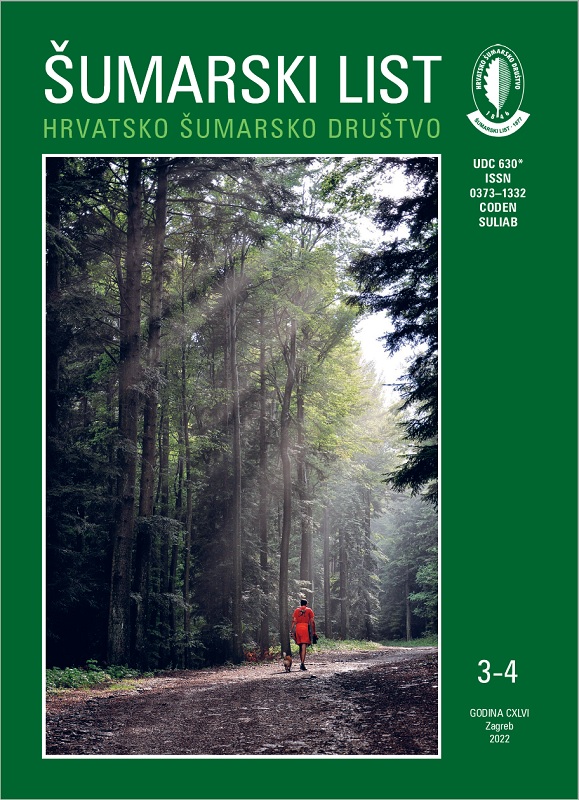
broj: 3-4/2022
pdf (12,34 MB) |
|
||||||||||||||
| RIJEČ UREDNIŠTVA | ||
| Uredništvo | ||
| Do we use biomass as an energy source? If so, how do we use it? pdf HR EN | 101 | |
| IZVORNI ZNANSTVENI ČLANCI | ||
| David Janeš, Andreja Đuka, Ivica Papa, Tibor Pentek, Maja Moro, Ivan Žarković, Tomislav Poršinsky | UDK 630* 686 + 463 (001) https://doi.org/10.31298/sl.146.3-4.1 | |
| Indicators of primary forest accessibility in different terrain categories pdf HR EN | 103 | |
| Kristijan Tomljanović, Marijan Grubešić, Danko Diminić, Milan Poljak, Jelena Kranjec Orlović | UDK 630* 156 + 451 (001) https://doi.org/10.31298/sl.146.3-4.2 | |
| Red deer (Cervus elaphus L.) damage on stands of narrow-leaved ash (Fraxinus angustifolia Vahl) of Middle Posavina pdf HR EN | 117 | |
| Mustafa Arslan, Arzu Ucar Turker, Isa Tas, Arzu Birinci Yildirim, Erva Ozkan | UDK 630* 423 (001) https://doi.org/10.31298/sl.146.3-4.3 | |
| Determination of some phenolic substances in six different populations of turkish hazel (Corylus colurna L.) leaves and comparison of phenolic fluctuation with water deficiency pdf HR EN | 127 | |
| Ender Bugday | UDK 630* 261 (001) https://doi.org/10.31298/sl.146.3-4.4 | |
| A GIS based landslide susceptibility mapping using machine learning and alternative forest road routes assessment in protection forests pdf HR EN | 137 | |
| PRETHODNO PRIOPĆENJE | ||
| Zdravko Dolenec | UDK 630* 148.2 https://doi.org./10.31298/sl.146.3-4.5 | |
| Dates of arrival of the Eurasian golden oriole (Oriolus oriolus L.) in decidious forest in relation to increase of local air temperature in NW Croatia pdf HR EN | 149 | |
| PREGLEDNI ČLANCI | ||
| Matija Bakarić, Ivan Martinić, Mario Šporčić, David Mijoč, Matija Landekić | UDK 630* 641 https://doi.org/10.31298/sl.146.3-4.6 | |
| Entrepreneurial infrastructure and entrepreneurship in forestry of Croatia – possibilities and perspectives pdf HR EN | 153 | |
| Summary The introduction provides an overview of a wide range of definitions of entrepreneurship and a brief overview of the situation and issues through institutional and legislative review. The second chapter presents the key features of forestry entrepreneurship in the Republic of Croatia. The main indicators of improving services in the forestry sector through the use of entrepreneurial services are discussed. Emphasis was also placed on comparison with EU standards through small business. Subsection 2.1 provides an overview of entrepreneurial opportunities in the forestry sector with special emphasis on innovative activities in which young forestry professionals could find themselves in the business of improving existing products and services, new services and new products. The third chapter lists the elements of entrepreneurial infrastructure through their facilities and all assessed in Table 1 through a SWOT analysis which shows the characteristics of strengths and weaknesses as internal characteristics and opportunities and threats as external characteristics. Section 3.1 lists the entrepreneurial support institutions established under the Law of the Improvement of Entrepreneurial Infrastructure. Subsection 3.2 provides an institutional framework for entrepreneurship management through strategic documents and laws with their characteristics. Subsection 3.3 shows aid to entrepreneurs from the EAFRD Fund for Rural Development. Table 2 shows the types of operations intended for the forestry sector together with the business entities for which they are intended and the amount and intensity of support. Subchapter 3.4 shows the support provided by the Republic of Croatia for the development of entrepreneurial activities, primarily through the credit lines of the Hrvatska banka za obnovu i razvoj (HBOR) and HAMAG-BICRO. Table 3 shows the currently available HBOR credit lines which are used as a starting point for selecting the most applicable for the forestry sector. From the shown credit lines, three are compatible and potentially applicable in the forestry sector. At the same time, these lines are shown with their characteristics in Table 4. Furthermore, the Croatian Government Agency HAMAG-BICRO also encourages the establishment of the forestry sector through three models shown in Table 5 with its characteristics for a successful promotion of entrepreneurship. forestry. In the last chapter, instead of conclusions, the problem of the lack of mass of potential entrepreneurs, primarily from a population of young forestry professionals, is mentioned. This is due to the lack of consideration by forestry experts about entrepreneurship as an interesting option. The impetus for thinking about entrepreneurship is certainly the simplified establishment of a business entity and the growing number, although still an insufficient number of credit lines for newly established business entities. Key words: innovation; economic development; start-up; supports | ||


